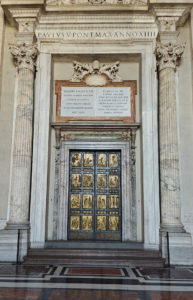The Holy Door is the emblematic symbol of each Jubilee. Normally closed for a quarter of a century, it is finally opened on Christmas Eve to inaugurate the Year of Mercy. Like any sign, that of the door is full of meaning. Its roots go back to the Old Testament. Many important events took place at the entrance to cities: justice was administered, sermons were preached, and treaties were signed. The Jews dyed the doorposts of their houses with the blood of the lamb to protect themselves from the passage of the angel of death. There are also episodes in which God speaks to Moses on the threshold of the tabernacle. In short, the door was the place of encounter between peoples and also between God and man.
With the coming of Christianity, the importance of this symbol was inherited. There are numerous passages in the New Testament that confirm its value, such as in the Book of Revelation: “Behold, I stand at the door and knock. If anyone hears my voice and opens the door, I will come in to him and eat with him, and he with me” (Rev 3:20). The Lord, then, is like a traveller who asks to be received; He is the divine guest who comes to meet man in order to bring him salvation. He himself has defined himself as the door of the sheepfold(cf. Jn 10:7), showing Himself as the way for our lives. He is both the means and the end, because to meet Christ is to cross the threshold of heaven, to taste paradise.
The Jubilee tradition of opening the Holy Door is based on this scriptural foundation. Historically, it was Pope Martin V who institutionalised this custom in 1423. He was followed by Pope Alexander VI, who made this sign even more prominent, accompanied by a careful ceremony to inaugurate the special year of grace. From this Jubilee, the Pope established the opening of four doors, corresponding to the main basilicas: St Peter’s, St John Lateran, St Mary Major and St Paul’s Outside the Walls.
Undoubtedly, especially since then, the Door has become an emblematic symbol of the abundance of gifts of grace that the Church gives to the world through the Jubilee. Closed for a quarter of a century, it symbolises humanity in the darkness of waiting. It is not by chance that this door opens wide on the eve of the birth of Jesus. On that night, the light that illuminates the darkness is made flesh and becomes the means of salvation (cf. Jn 10:9). Crossing that threshold is therefore not just a tradition, but a true profession of faith: one proclaims the Lord as the Saviour of the world and exclaims with Peter that Jesus is the Christ, the Messiah so longed for by Israel (cf. Mt 16:16) and desired by humanity.
